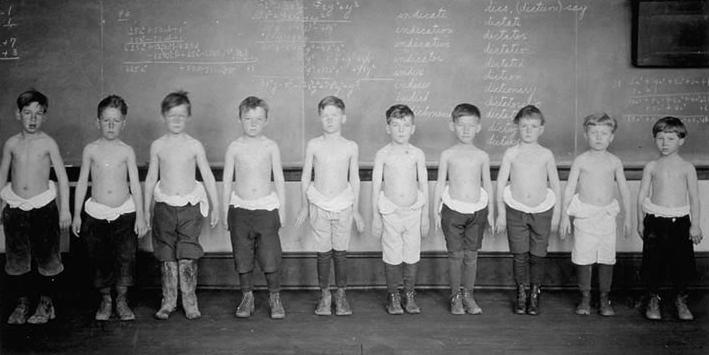
Baltimore Anthropometric Study: 6 and 7 Year Olds (1922)

Figure 1.--Eugenicists had a passion for measurement. This was in part because they insisted that Eugenics was a science. This is a series of photographs taken for a Baltimore anthropometric study in 1922. The photograph here includes the younger primary children (6-7 year olds). This may be a frst grade class which after the begging of school would have 6-7 year olds. All of the boys appear to be wearing a one piece underwear which is bunched at their waist to show their bare chest for the photo. Notice that 7 of the boys wear straight knee pants. Knee pants were not very fashionable in 1922, most boys worne knickers. This is one reason we think this may be an orphanage. They also wear dark long stockings.
|
|
Eugenicists had a passion for measurement. This was in part because they insisted that Eugenics was a science. This is a series of photographs taken for a Baltimore anthropometric study in 1922. The photograph here includes the younger primary children (6-7 year olds). This may be a frst grade class which after the begging of school would have 6-7 year olds. All of the boys appear to be wearing a one piece underwear which is bunched at their waist to show their bare chest for the photo. Notice that 7 of the boys wear straight knee pants. Knee pants were not very fashionable in 1922, most boys worne knickers. This is one reason we think this may be an orphanage. They also wear dark long stockings. The three boys on the left may be wearing knickers, I cannot tell. The third boy in from left appears to be wearing some sort of boots. The variety of length of trousers is interesting. All of the boys appear to be wearing a one piece underwear which is bunched at their waist to show their bare chest for the photo. You cannot tell from the photo but all of the trousers probably attach to under waists or combination suits. Some of the boys’ trousers have fly fronts most do not.
Another interesting detail about this fascinating photo and the underwear is that the boys are mostly wearing union suits--probably waist union suits, since the boys are also wearing black long stockings. If the boys had been wearing underwaists, they would probably have had to remove these as well as unfasten the garters holding up their stockings. But with waist union suits, all they have to do is unbutton the top part, slip
their arms out of the undershirt part, and roll the upper part of the
garment down around their waists. This accounts for the configuration
of underwear bunched up around their middles. Presumably the garters,
attached to tabs on the waist union suits, don't have to be removed.
Waist union suits were very popular in the 1920s.
We do not believe that such uniformity would have been the case in a regular public school class. It suggests to us thsat the study was done in an arphanage.
HBC

Navigate the Boys' Historical Clothing Web Site:
[Return to Main Baltimore study page]
[Return to Main U.S. eugenics measurements movement page]
[Return to Main U.S. eugenics page]
[Return to Main eugenics page]
[Introduction]
[Activities]
[Biographies]
[Chronology]
[Clothing styles]
[Countries]
[Bibliographies]
[Contributions]
[FAQs]
[Glossaries]
[Images]
[Links]
[Registration]
[Tools]
[Boys' Clothing Home]
Created: 9:59 PM 9/11/2009
Last updated: 10:00 PM 9/11/2009



